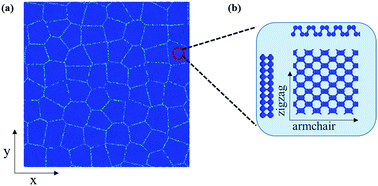当前位置:
X-MOL 学术
›
Phys. Chem. Chem. Phys.
›
论文详情
Our official English website, www.x-mol.net, welcomes your
feedback! (Note: you will need to create a separate account there.)
Abnormal linear elasticity in polycrystalline phosphorene†
Physical Chemistry Chemical Physics ( IF 2.9 ) Pub Date : 2018-03-08 00:00:00 , DOI: 10.1039/c7cp08540k Ning Liu 1, 2, 3, 4 , Ramana Pidaparti 1, 2, 3, 4 , Xianqiao Wang 1, 2, 3, 4
Physical Chemistry Chemical Physics ( IF 2.9 ) Pub Date : 2018-03-08 00:00:00 , DOI: 10.1039/c7cp08540k Ning Liu 1, 2, 3, 4 , Ramana Pidaparti 1, 2, 3, 4 , Xianqiao Wang 1, 2, 3, 4
Affiliation

|
Phosphorene, also known as monolayer black phosphorous, has been widely used in electronic devices due to its superior electrical properties. However, its relatively low Young's modulus, low fracture strength and susceptibility to structural failure has limited its application in nano devices. Therefore, in order to design more mechanically reliable devices that utilize phosphorene, it is necessary to explore the mechanical properties of polycrystalline phosphorene. Here molecular dynamics simulations are performed to study the effect of grain size on the mechanical performance of polycrystalline phosphorene sheets. Unlike other two-dimension materials with planar crystalline structure, polycrystalline phosphorene sheets are almost linear elastic, resulting from its high bending stiffness due to its intrinsic buckled crystalline structure. Moreover, the percentage increase of stiffness for polycrystalline phosphorene associated with the increase of grain size from 2 to 12 nm is only 15.9%, much smaller than that for other two-dimension materials with planar crystalline structure. This insensitivity could be attributed to the small difference between the elastic modulus of the crystalline phase and amorphous phase of polycrystalline phosphorene. In addition, the strength deduction obeys well a logarithm relation of grain size, well explained by the dislocation pile-up theory analogous to that of polycrystalline graphene. Overall, our findings provide a better understanding of mechanical properties of polycrystalline phosphorene and establish a guideline for manufacturing and designing novel phosphorene-based nano devices and nano structures.
中文翻译:

多晶磷烯中的线性弹性异常†
磷,又称单层黑磷,由于其优越的电性能已被广泛用于电子设备中。然而,其相对较低的杨氏模量,较低的断裂强度和对结构破坏的敏感性限制了其在纳米器件中的应用。因此,为了设计利用磷的机械上更可靠的装置,有必要探索多晶磷的机械性能。这里进行分子动力学模拟以研究晶粒尺寸对多晶磷片的机械性能的影响。与其他具有平面晶体结构的二维材料不同,多晶磷片几乎是线性弹性的,这归因于其固有的弯曲晶体结构所具有的高弯曲刚度。此外,与晶粒尺寸从2到12 nm的增加相关的多晶磷光体的刚度增加百分比仅为15.9%,远小于其他具有平面晶体结构的二维材料的刚度增加百分比。这种不灵敏性可以归因于多晶磷光体的结晶相和非晶相的弹性模量之间的微小差异。另外,强度的降低很好地遵循了晶粒尺寸的对数关系,这由位错堆积理论很好地解释了,该理论类似于多晶石墨烯。总体而言,我们的发现提供了对多晶磷烯机械性能的更好理解,并为制造和设计新颖的基于磷烯的纳米器件和纳米结构建立了指南。与晶粒尺寸从2到12 nm的增加相关的多晶磷光体的刚度增加百分比仅为15.9%,远小于其他具有平面晶体结构的二维材料的刚度增加百分比。这种不灵敏性可以归因于多晶磷光体的结晶相和非晶相的弹性模量之间的微小差异。另外,强度的降低很好地遵循了晶粒尺寸的对数关系,这由位错堆积理论很好地解释了,该理论类似于多晶石墨烯。总体而言,我们的发现提供了对多晶磷烯机械性能的更好理解,并为制造和设计新颖的基于磷烯的纳米器件和纳米结构建立了指南。与晶粒尺寸从2到12 nm的增加相关的多晶磷光体的刚度增加百分比仅为15.9%,远小于其他具有平面晶体结构的二维材料的刚度增加百分比。这种不灵敏性可以归因于多晶磷光体的结晶相和非晶相的弹性模量之间的微小差异。另外,强度的降低很好地遵循了晶粒尺寸的对数关系,这由位错堆积理论很好地解释了,该理论类似于多晶石墨烯。总体而言,我们的发现提供了对多晶磷烯机械性能的更好理解,并为制造和设计新颖的基于磷烯的纳米器件和纳米结构建立了指南。
更新日期:2018-03-08
中文翻译:

多晶磷烯中的线性弹性异常†
磷,又称单层黑磷,由于其优越的电性能已被广泛用于电子设备中。然而,其相对较低的杨氏模量,较低的断裂强度和对结构破坏的敏感性限制了其在纳米器件中的应用。因此,为了设计利用磷的机械上更可靠的装置,有必要探索多晶磷的机械性能。这里进行分子动力学模拟以研究晶粒尺寸对多晶磷片的机械性能的影响。与其他具有平面晶体结构的二维材料不同,多晶磷片几乎是线性弹性的,这归因于其固有的弯曲晶体结构所具有的高弯曲刚度。此外,与晶粒尺寸从2到12 nm的增加相关的多晶磷光体的刚度增加百分比仅为15.9%,远小于其他具有平面晶体结构的二维材料的刚度增加百分比。这种不灵敏性可以归因于多晶磷光体的结晶相和非晶相的弹性模量之间的微小差异。另外,强度的降低很好地遵循了晶粒尺寸的对数关系,这由位错堆积理论很好地解释了,该理论类似于多晶石墨烯。总体而言,我们的发现提供了对多晶磷烯机械性能的更好理解,并为制造和设计新颖的基于磷烯的纳米器件和纳米结构建立了指南。与晶粒尺寸从2到12 nm的增加相关的多晶磷光体的刚度增加百分比仅为15.9%,远小于其他具有平面晶体结构的二维材料的刚度增加百分比。这种不灵敏性可以归因于多晶磷光体的结晶相和非晶相的弹性模量之间的微小差异。另外,强度的降低很好地遵循了晶粒尺寸的对数关系,这由位错堆积理论很好地解释了,该理论类似于多晶石墨烯。总体而言,我们的发现提供了对多晶磷烯机械性能的更好理解,并为制造和设计新颖的基于磷烯的纳米器件和纳米结构建立了指南。与晶粒尺寸从2到12 nm的增加相关的多晶磷光体的刚度增加百分比仅为15.9%,远小于其他具有平面晶体结构的二维材料的刚度增加百分比。这种不灵敏性可以归因于多晶磷光体的结晶相和非晶相的弹性模量之间的微小差异。另外,强度的降低很好地遵循了晶粒尺寸的对数关系,这由位错堆积理论很好地解释了,该理论类似于多晶石墨烯。总体而言,我们的发现提供了对多晶磷烯机械性能的更好理解,并为制造和设计新颖的基于磷烯的纳米器件和纳米结构建立了指南。











































 京公网安备 11010802027423号
京公网安备 11010802027423号